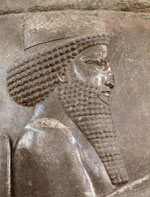|
On
two occasions, Egypt was integrated into the Persian empire. The first Persian
domination lasted for 120 years. The Great Kings were represented at Memphis by
a satrap and a treasurer, but on the ideological level, these emperors were the
successors of the Saite kings and composed Manetho's Twenty-seventh Dynasty.
Since the Saites had enabled the economy and the culture of Egypt to flourish
brilliantly, Cambyses and Darius I acquired an especially lucrative province.
While the Persians recruited native officials who were highly qualified to
administer the land, they also settled or reinforced the foreign garrisons (the
Judeo-Aramaeans of Elephantine) and gave Greek and Phoenician merchants a freer
hand. Around 445 b.c.e., under Artaxerxes I,
Herodotus
visited Egypt. Cambyses and especially Darius I, were depicted as genuine
pharaohs on both public and private monuments. |
||


 Considerable
period of his rule he spent putting down numerous uprising which were
breaking out after death of Darius the Great all over the land. Both
Considerable
period of his rule he spent putting down numerous uprising which were
breaking out after death of Darius the Great all over the land. Both